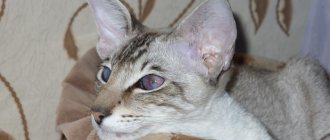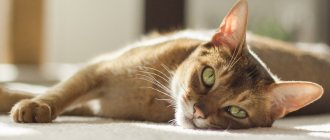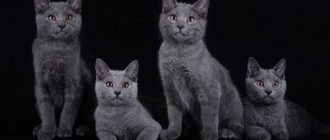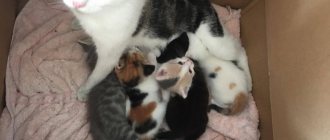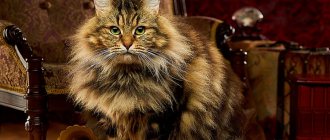What does an exotic cat look like?
Even a child can tell what an exotic cat looks like, the breed is so popular. In the photo, the exotic cat looks like a plush toy, but its personality doesn't quite match its appearance.
Muzzle
The exotic head is powerful and round in shape. The skull has wide, strong bones. The chin is strongly developed and has a round shape. The cheeks are very dense and fleshy. The jaws are strong and wide.
The eyes are round and large in size. They are located on the same line, but quite far from each other. The eye color of Persian cats is usually copper, dark copper, orange or yellow; in chinchillas – green, emerald green; Blue eye color is found in white cats and is required for color-point cats. The nose, paw pads, and whiskers correspond to the main color.
The ears are small, neatly round in shape. They are located low and also slightly tilted forward.
The pet's nose is very wide, but short and strongly turned up. The lobe is located almost between the eyes.
Body type
The general impression of a soft toy that resembles an exotic animal is deceptive. In fact, cats have a massive body, strong and slightly heavy bones. The body size is medium-sized with a broad chest and massive shoulders. The body itself is squat, with strong muscles and almost no fat. Varieties of exotic cats are not distinguished by body type or face shape.
The front and hind limbs of the animal are short, with strong bones. When looking at the cat, you can see that they are standing straight, parallel to each other. The hocks of this handsome plush are large, round in shape. There are 5 toes on the front paws, and 4 on the hind paws.
The tail of exotics is shortened, without bends. When at rest, it is located below the back.
Coat and color
The fur of an exotic cat is thick, of medium length, with a dense undercoat. It feels very soft and plush to the touch.
Exotic cats have the greatest variety of colors compared to other breeds. There are many varieties of recognized exotic cat colors:
- solidas, or solid colors from white to black, also include lilac, chocolate or fawn;
- tortoiseshell cats with white spots;
- patterned colors such as tabby or merle;
- color points are seal point, blue point, red point, cream point;
- tipping colors - chinchillas (silver, golden, cameo), as well as shaded, veiled.
Various combinations of colors and patterns make choosing a pet very difficult.
Description of the breed
The Exotic Shorthair is a medium to large sized cat with short, thick legs and a muscular, squat body. The head is massive, rounded, with a wide skull located on a short and thick neck.
The eyes are large, round, and widely spaced. The nose is short, snub-nosed, with a wide depression located between the eyes. The ears are small, with rounded tips, and set wide apart. When viewed in profile, the eyes, forehead, and nose are on the same vertical line.
The tail is thick and short, but proportional to the body. Mature cats weigh from 3.5 to 7 kg, females from 3 to 5.5 kg. Type is more important than size, the animal must be balanced, all parts of the body must be in harmony with each other.
The coat is soft, dense, plush, and has an undercoat. Like Persian cats, the undercoat is thick (double coated), and although it is a short-haired species, the overall length of the coat is longer than other short-haired breeds.
According to the CFA standard, it is of medium length, the length depends on the undercoat. There is a large plume on the tail. Dense fur and a round body make the cat look like a teddy bear.
Exotics can come in a variety of colors and colors, the number is such that it makes no sense to even list them. Including point colors. Eye color depends on the coat. Outcrossing with Persian and Himalayan cats is acceptable in most associations.
Character of an exotic cat
The character of an exotic cat matches its pleasant appearance, but not one hundred percent. She successfully combines good nature and tact with affection for a person.
The domestic exotic sincerely loves all family members, but he will feel the greatest devotion to the one whom he considers his master. It is from him that the pet wants to receive maximum attention, and is also most sad during his absence. In general, you should not leave your cat alone for a long time. He will become very sad, he will have a grudge against his owner.
Despite the fact that exotics seem clumsy, they are quite energetic and active. It is important for pet owners to remember that due to excessive curiosity, they sometimes end up in unpleasant situations or even harm themselves. You should not leave cats alone near open windows or balconies in an apartment, as the innate hunting qualities of these animals can make them rush after a fly, butterfly, or bird.
Short-haired cats show almost no signs of aggression towards other creatures. They calmly accept excessive affection from small children, tolerate their pranks, and sometimes don’t mind playing ball with them or running races. Exotics remain playful creatures until old age, but their level of activity decreases slightly with age.
Plush creatures get along well with other pets. They do not try to take a leading position, but they will not act as subordinates either. They try to remain neutral, preferring to observe everything from the outside.
How the breed originated
In the 1960s In America, breeders tried to cross a Persian cat with an American shorthair. It is known that the Russian Blue Longhair also took part in the experiment. The purpose of the experiment was to diversify the color range of the American cat breed.
The result surprised and exceeded all expected expectations: the kittens obtained through selection had the anatomical structure of the head and round muzzle similar to the Persians, and the fur captivated with its thickness and unusually pleasant velvety to the touch. In other words, the opposite result was obtained: the improvement affected not the American breed, but the Persian one, since the kittens had the appearance of a Persian, with short thick legs and a snub nose.
Now the next step is the question of registration. A dilemma has arisen: should we register the kittens as a new breed or consider it one of the varieties of Persians? At one of the meetings of the World Association of Animal Lovers, convened on this occasion, the first option received more votes, and the exotic was recognized and registered as an independent breed of “exotic shorthair”.
Raising an exotic cat
Exotic shorthair cats are highly intelligent and therefore easy to train. Raising pets begins from the first days of their appearance in the house. The main thing is to accustom the kitten to the tray and scratching post. As a rule, there are no problems with this, because smart exotics quickly remember the necessary rules of behavior.
A toilet with a comfortable filler is installed in a quiet place so that the baby can do his business without being distracted by external irritants. At first, you need to put him in the tray at the first signs of anxiety and sniffing the corners. It is worth holding the kitten there for several minutes, not forgetting to stroke it. This way he will not have a feeling of fear or hostility.
You can teach him to use a scratching post using a special solution from a pet store. It is simply sprayed onto the surface. You can use valerian tincture for these purposes.
Reviews from owners of exotic pets indicate that they are quite capable of following basic commands and also quickly learn prohibition words. They understand well the timbre of the voice or intonation of the owner. Therefore, you should not shout at the cat or raise your hand to it. Bullying will harm your pet's mental and physical health.
Exotic cat: history of the breed
The ancestors of exotic cats are representatives of the famous American Shorthair and Persian breeds. In the 60s of the 20th century, breeders decided to improve the coat of the American Shorthair cat, adding to it the silkiness and softness of the Persian breed, as well as new colors to the range familiar to American women.
In fact, the breed is the fruit of an “unsuccessful” experiment of crossing an American Shorthair cat and a Persian. From this, the cat received a somewhat heavy skeleton with thick paws, plush fur, an “owl” face with eternally sad and surprised eyes.
However, the resulting exotic is rapidly gaining popularity and is one of the most popular cat breeds. The special character of the pet, which differs from the customs of its ancestors, was also a discovery.
In America, the exotic shorthair cat officially received the status of a new breed in 1966. Experiments on it continued for several more years. There have been attempts at mating with British, Russian Blue and Burmese cats. In 1975, all experiments by breeders were stopped, and Persians remained permissible for crossing to obtain a pure exotic breed. Since long-term mating of exotic cats with each other deteriorates the texture of the pet’s coat, exotic cats cannot do without “infusion” of Persian blood into the breed.
In America, the Exotic Shorthair cat officially received the status of a new breed in 1966.
Exotic cats were not accepted as a separate breed for a long time, considering them “cut” Persians. Only the growth of popularity has led to the breed being recognized throughout the world. The next round of popularity of the breed is associated with the appearance in 2011 of a kitten of an exotic smooth-haired breed named Snoopy on social networks. The Chinese girl simply showed off her favorite to her friends, not suspecting that she would become a world star. Today the cat Snoopy is the second name of the breed.
Exotic cat health
Possible diseases
Exotics are a human-bred breed, that is, they have not undergone natural selection. They are characterized by the same genetic diseases as their closest relatives - Persian cats. Therefore, the health of an exotic cat must be controlled by the owner.
The characteristic structure of the muzzle causes problems associated with disturbances in the shape of the nasolacrimal duct. This provokes diseases of the eyes and respiratory system. Pets often suffer from a runny nose due to hypothermia and exposure to drafts. Inflammation of the lacrimal glands leads to the development of conjunctivitis, and in the future it worsens exotic vision.
The oral cavity and teeth are also susceptible to the development of infectious diseases. The most common are gingivitis, stomatitis, and periodontal disease. This can be avoided if you carefully take care of the health of your cat's teeth and gums. Some animals experience abnormal development of the lower jaw. This pathology causes difficulty eating.
Unbalanced nutrition and overfeeding lead to the development of obesity in the pet. Problems with excessive weight provoke disturbances in the functioning of the animal’s cardiovascular system. Food allergies occur when food from the host’s table is overused.
For prevention, it is necessary to carry out routine vaccination of the cat. The first vaccinations are given at the age of 8 weeks, then at 12 weeks. An adult is vaccinated annually. Veterinarians offer medications for a whole range of infectious diseases: rabies, herpes, hepatitis, calcivirosis, distemper and some others.
Regular examination by a specialist, timely vaccinations, proper care and a balanced diet will help maintain the health of your exotic plush for many years.
Reproductive health
Exotic cats become fully physically developed by the age of one and a half years. Only then do owners begin to think about breeding a pet. Only purebred individuals should be considered. Before the procedure, you need to conduct an examination with a veterinarian, who must make sure that the future parents do not have diseases.
Pregnancy should be under the supervision of a doctor. You should increase your cat's nutritional intake and give her vitamin and mineral complexes recommended by your veterinarian. After 65 days, an average of 4-6 kittens are born. Childbirth usually takes place without complications, but to avoid problems, the presence of a doctor is advisable. Exotics become very sensitive parents.
Sterilization and castration are recommended until the age of one. This will help prevent complications and significantly improve your pet's standard of living.
Features of feeding and diet
The healthy development of a pet is impossible without adequate nutrition. We must not forget about the tendency of exotic animals to overeat and obesity, so it is important to take into account not only the nutritional norm, but also its balance.
The cat menu can be of three types:
- natural;
- dry;
- mixed.
Each of them has its own characteristics. For example, when offering industrial food to your pet, you cannot save money. Only premium and super-premium products contain all the microelements and vitamins necessary for proper development. Dry and wet food at a cheap price category causes irreparable harm to the health of exotic animals. There are known cases of animal death due to harmful components contained in dry food from unscrupulous manufacturers.
Natural nutrition requires the owner to follow strict rules for organizing the pet’s diet. Most of the menu should consist of low-fat meat products: rabbit, chicken, beef, veal, lamb. Twice a month you can pamper your exotic with sea fish in the form of boneless fillets, as well as offal.
Porridge cooked in meat broth is also useful to include in the diet of exotic breed cats. Experienced breeders prefer oatmeal, buckwheat and rice. It is useful to mix them with pureed vegetables. For example, eating pumpkin or carrots for animals will help avoid problems with intestinal function.
Complementary feeding for one-month-old kittens begins with low-calorie fermented milk products. It is necessary to offer the baby cottage cheese, and once a week - a boiled chicken egg. Kittens are given low-fat milk, but it is not advisable for adults.
You cannot offer cats food from the owner's table, and the following are also harmful to them:
- sweets;
- pork;
- tubular bones;
- bony river fish;
- spicy, salty and smoked foods.
A mixed diet involves alternating dry or wet industrial food and natural food. We must not forget about the exotic drinking regime. Clean, fresh water should always be in your pet's bowl. If a cat eats ready-made food, it needs more water.
How many times to feed your pet depends on its age and weight. For example, a kitten from 1 month to 4 months is fed at least four times a day. By 6 months, the number of feedings is reduced to three times. From six months onwards they switch to a two-time feeding regimen.
Care and maintenance
Due to some peculiarities of care and maintenance, the exotic cat is called the lazy Persian. This indicates their unpretentiousness, but not a lack of care at all.
Your pet's thick coat needs regular brushing. It is combed out at least twice a week using a special comb made of metal. Exotics are a very clean breed, so they carefully lick themselves. Therefore, it is necessary to regularly give them medications to remove hairballs from the stomach. Such medications are purchased from veterinary pharmacies and used strictly according to the instructions. They can be replaced with fresh grass.
The exotic needs to be bathed once a month. This is done in a non-slip basin with warm water using a special shampoo for short-haired cats. It is necessary to soap the animal twice, because the thick undercoat does not allow moisture to penetrate its skin well. After washing, the pet is wrapped in a large warm towel and left in a room away from drafts. Before water procedures, cotton wool is inserted into the cat's ears to prevent water from getting into them.
The exotic's eyes and nose need daily wiping. This is due to the unusual structure of its muzzle. The eyes are wiped with a dry cloth or cotton pad soaked in a special lotion. Once a week, the ears are cleaned of accumulated dirt using a cotton swab.
Exotics, like other domestic cats, have their nails trimmed. Do this twice a month, cutting off no more than 2 mm of the nail plate. For cutting, use small nail clippers and a regular nail file. If a cat walks on the street (lives in a private house), then the claws are cut less often, as they grind down on their own.
When an exotic kitten appears in an apartment, he needs to be given a quiet, warm place, equipped with a comfortable soft bed. To prevent the animal from feeling loneliness, it should not be placed far from people. In this case, he will be scared and lonely. Drafts are dangerous for the health of your plush pet, so you should close the vents or windows in a timely manner.
Care
Caring for exotics is not as simple as we would like, but there are no particular difficulties. The features of their care are the same as those of the Persian. They are associated with the characteristics of their health - some physiological deficiencies:
- Difficulty breathing (due to a flattened nose), which is sometimes accompanied by snoring;
- Deformation of the jaw (teeth);
- Tearing, due to which the animal’s eyes need to be monitored daily.
Otherwise, these cats have fairly good health, which they inherited from their second parent - the “American”. If we talk about caring for exotics, in addition to washing the eyes, then we must not forget about the following points:
- take care of the claws by providing a scratching post, do not forget to trim the tips of the claws;
- comb the hair (once a week) and wash the cat once a season (three months), but more often during the molting period;
- After washing, it is advisable to dry the cat's fur, since the undercoat is quite thick and takes a long time to dry. If you don't help your cat dry out, it may catch a cold;
- Do not forget about proper feeding (do not feed human food): balance and vitamins;
- It is necessary to periodically remove worms and fleas from your cat.
Try to give love to the exotic and give more attention, since this is the main condition for their life expectancy (from loneliness they become depressed and die much earlier).
Tips for choosing a kitten
When choosing a future pet, it is important to consider the purpose of its acquisition. When buying a baby as a companion or to participate in exhibitions, you should pay attention to the following points:
- soft, not bloated tummy;
- clean ears and eyes;
- teeth without yellow plaque;
- soft and dense fur.
Before buying, you need to observe the baby’s behavior. He must be active, inquisitive, playful. Fearfulness is characteristic only of adults, and in kittens it is a bad sign.
Exotic kittens are taken from the breeder at the age of three months. By this time, the baby should acquire a veterinary passport with notes on the routine vaccination. Also, by this age, exotics should have basic hygiene skills and have strong immunity due to maternal feeding. By this time they already know how to feed themselves. Therefore, it would be a good idea to inquire about the type of food the kitten is eating and the brand of litter for the trays.
The seller is obliged to provide documents on the pedigree of the parents upon the first request of the buyer. Ask to see the baby's mother, make sure she is in good physical and mental health. If exterior is important to you, then first familiarize yourself with the breed standards of an exotic cat or consult with an experienced owner.
Origin story
The date of appearance of the Exotic cat is the middle of the last century.
The breeders initially set themselves the goal of obtaining a different eye color and diversifying the palette of colors in American shorthair cats, so they brought the latter together with Persian individuals. However, the task failed: the kittens had absolutely Persian faces and bodies. Only one thing has changed: the fur has become shorter and plusher. They decided to develop the breed further. It was first introduced to the public in 1966 by Jane Martink, but exotica did not achieve popularity immediately. For a long time it was believed that they were an ordinary marriage, and that one should not encroach on the purity of the Persian breed.
Many breeders refused to breed exotics and Persians, but they found some less scrupulous people among them. Gradually, both the Burmese cat and the Russian Blue were involved in the work, but when the shorthair gene was fixed, such matings stopped completely.
The breed received a standard in 1990: it was identical to the Persian, but differed in the requirements for wool. And to this day, if changes are made to the Persian breed standard, the same will automatically change for shorthaired exotics.
